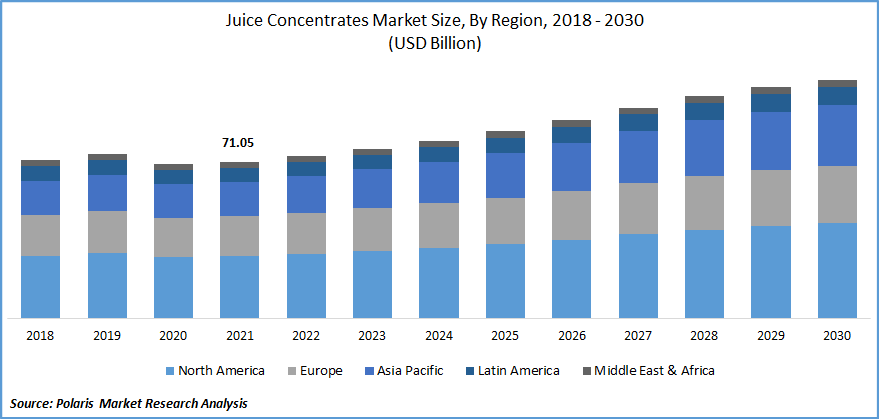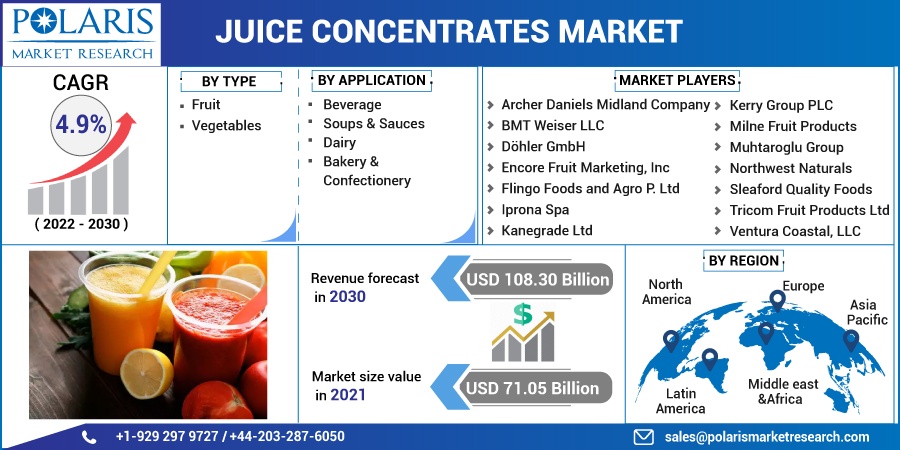
Juice Concentrates Market Share, Size, Trends, Industry Analysis Report By Type (Fruit Juice Concentrates, Vegetables Juice Concentrates); By Application; By Region; Segment Forecast, 2022 - 2030
- Published Date:Jun-2022
- Pages: 112
- Format: PDF
- Report ID: PM2491
- Base Year: 2021
- Historical Data: 2018-2020
Report Outlook
The global juice concentrates market was valued at USD 71.05 billion in 2021 and is expected to grow at a CAGR of 4.9% during the forecast period. The juice concentrates refer to vegetable and fruit juice that have low water content. Concentrated fruit drink is known to be more affordable as compared to normal fruit drink.
 Know more about this report: Request for sample pages
Know more about this report: Request for sample pages
The shelf life of the product is increased by reducing bacterial growth with the removal of water. The whole fruit is thoroughly rinsed, washed, squashed, or mixed to make pulp. The water is generally extracted or evaporated, which is beneficial as the pulp is rich in nutrients. As an alternative to vegetables and fruits, juice concentrates are utilized in a variety of food industry applications such as confectionery, sauces, bread items, and soups.
The global juice concentrates market is driven by the growing demand for healthy and convenient foods. They are a cost-effective and convenient alternative for fresh drinks in a variety of applications. The evolving lifestyle, growing disposable incomes, and urbanization are major factors that are responsible for the overall growing demand for fruit concentrates across the globe.
Fruit concentrates are primarily used in the beverage industry for making fruit soft drinks, nectars, and alcoholic drinks. The fruit concentrates are also used in bakery, confectionery, and dairy industries as they provide flavor, sweetness along with nutritional value to the product.
There has been an increase in demand for these drinks during the pandemic owing to greater demand for convenience food products. However, the supply and production of such fruit drink concentrate have suffered a decline owing to disruptions in the supply chain, halting of manufacturing activities, and limited availability of raw materials.
Closure of restaurants and food outlets due to lockdown, government regulations on movement and lockdowns, and lack of labor have affected the growth of the industry. E-commerce platforms have gained popularity for the sale of beverages, soups & sauces, bakery & confectionery, especially during the pandemic.
Online platforms provide a plethora of options to consumers on a single portal, offering convenience and saving time & effort. Rigorous online marketing, along with attractive offers and discounts provided by companies, has increased the popularity of e-commerce over the years. The online distribution channel is well established in regions such as North America and Europe due to higher internet proliferation and greater adoption of mobile devices.
 Know more about this report: Request for sample pages
Know more about this report: Request for sample pages
Industry Dynamics
Growth Drivers
The increasing health consciousness, especially in most developed and developing economies, is expected to act as one of the major factors driving the growth of the juice concentrates market. The growing adoption of vegetable & fruit juices as an alternative to aerated drinks by health-conscious consumers and the growing popularity of convenience food & beverage products is expected to accelerate the overall industry growth.
The growing demand and usage of fruit juice concentrate as a substitute for sugar in the bakery sector also boost the industry growth. The growing health concerns among consumers and the demand for products made from natural & healthy ingredients will boost the industry's growth.
Moreover, the expansion of the bakery industry and confectionery, surge in disposable income, consumer preference towards convenience foods & ready-to-eat products and growing disposable income in developing economies will positively affect the juice concentrates market. Furthermore, cheaper and more convenient alternative in various applications extends profitable opportunities to the industry players over the forecast period.
Report Segmentation
The market is primarily segmented based on type, application, and region.
|
By Type |
By Application |
By Region |
|
|
|
Know more about this report: Request for sample pages
The Fruit Juice concentration segment is expected to witness the fastest growth
The fruit drink concentrates are used in a variety of industries, such as bakery & confectionery, food, beverage, and alcohol. Fruit drink concentrates, such as pear concentrates and apple concentrates, are used as sugar substitutes in the confectionery and bakery industry in the production of cookies, cakes, and pastries.
Fruit juice concentrates witness increasing demand worldwide, as there is a growing awareness regarding living a healthy life and consuming healthy products among consumers in both developing and developed economies. Fruits such as apples, oranges, and pineapple have significant demand owing to their health benefits. Fruit drinks, especially red grapes, are also used in the wine industry, which is one of the biggest opportunities to grow for the juice concentration market.
The major wine-producing countries, such as Australia, which produces wine on a huge scale, have a good market opportunity for the growth of the juice concentration market. Furthermore, the fruit drink concentrate also serves as an appropriate and convenient substitute for carbonated soft drinks and beverages.
The demand for beverages is expected to increase during the forecast period
Fruits and vegetable concentrates are widely used in the beverage industry for the production of both non-alcoholic as well as alcoholic beverages. The juice concentrates of fruit and vegetables are used in various beverages such as juices, tea, energy drinks, and smoothies and are available in different forms such as crystallized, frozen, or liquid.
The fruits such as apples and grapes are common fruits used to produce alcoholic beverages. Moreover, exotic superfruits, such as passion fruits and juniper berries, are also utilized to make alcoholic beverages. The growing adaption of concentrated juices in the alcoholic industry is fueling the overall growth of the industry.
The demand in the Asia Pacific is expected to witness significant growth
The demand for natural, healthy, and nutritious beverages is the driver of the growth of the market. The increasing disposable income of consumers and consumption of fast food drive the growth of this segment.
High penetration of quick-service restaurants and greater consumption of soft drinks has increased the demand for the industry in this region. Superior demand for healthy and organic food products has encouraged market players to develop new products catering to the local taste of consumers.
Competitive Insight
Some of the major players operating in the global market include Archer Daniels Midland Company, BMT Weiser LLC, Carolina Innovative Food Ingredients, Döhler GmbH, Encore Fruit Marketing, Inc, Flingo Foods and Agro P. Ltd, Iprona Spa, Kanegrade Ltd, Moleva, S.A, Kerry Group PLC, Milne Fruit Products, Muhtaroglu Group, Northwest Naturals, Sleaford Quality Foods, Tricom Fruit Products Limited, and Ventura Coastal, LLC.
These players are expanding their presence across various geographies and entering new markets in developing regions to expand their customer base and strengthen presence in the market. The companies are also introducing new innovative products in the market to cater to the growing consumer demands.
Recent Developments
In October 2019, Archer Daniels Midland announced a new product Isotonic Malt-Cola. This cola has a refreshing flavor, and also offers functional benefits to Middle Eastern consumers.
In September 2021, Kerry Group PLC acquired Hare Topco, Inc to expand its global food protection and preservation platform.
Juice Concentrates Market Report Scope
|
Report Attributes |
Details |
|
Market size value in 2021 |
USD 71.05 billion |
|
Revenue forecast in 2030 |
USD 108.30 billion |
|
CAGR |
4.9% from 2022 - 2030 |
|
Base year |
2021 |
|
Historical data |
2018 - 2020 |
|
Forecast period |
2022 - 2030 |
|
Quantitative units |
Revenue in USD billion and CAGR from 2022 to 2030 |
|
Segments covered |
By Type, By Application, By Region |
|
Regional scope |
North America, Europe, Asia Pacific, Latin America; Middle East & Africa |
|
Key companies |
Archer Daniels Midland Company, BMT Weiser LLC, Carolina Innovative Food Ingredients, Döhler GmbH, Encore Fruit Marketing, Inc, Flingo Foods and Agro P. Ltd, Iprona Spa, Kanegrade Ltd, Moleva, S.A, Kerry Group PLC, Milne Fruit Products, Muhtaroglu Group, Northwest Naturals, Sleaford Quality Foods, Tricom Fruit Products Limited, and Ventura Coastal, LLC |
